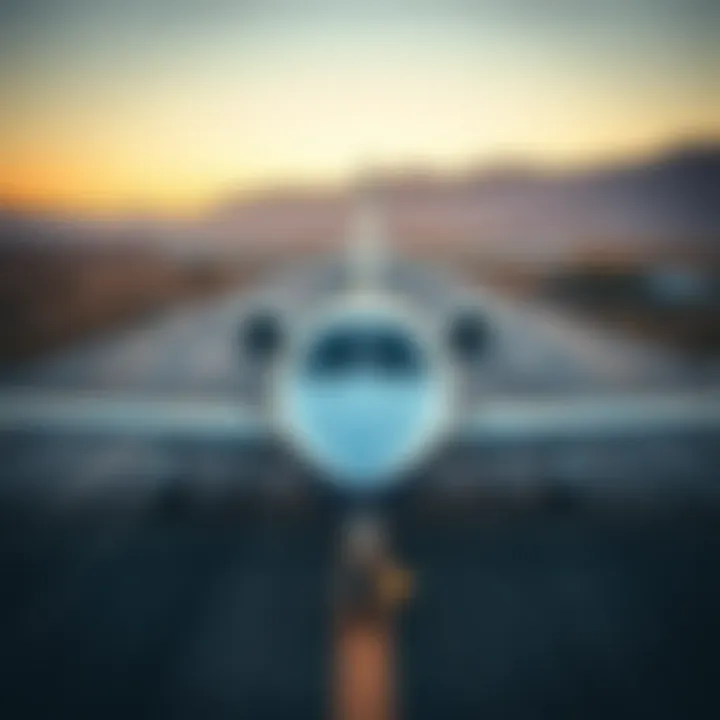Comprehensive Guide to Small Private Jet Costs


Intro
The world of small private jets is both fascinating and complex. For those looking into acquiring one, understanding the financial landscape is paramount. These aircraft represent not only a significant investment, but also come with a myriad of ongoing expenses that can catch buyers off guard. By delving into the costs associated with purchasing and operating a small private jet, potential owners can make informed decisions that align with their financial goals and lifestyle choices.
This discourse aims to explore various facets of spending involved in private aviation. We will analyze purchase prices, recurrent operational costs, and essential maintenance requirements. Each of these areas plays a crucial role in shaping the total cost of ownership, and understanding them can prevent unanticipated financial strain. Additionally, we’ll look at the nuances of financing options, helping you navigate through the complexities associated with buying a jet.
By the end of this article, readers should feel equipped with the knowledge necessary to approach ownership of a small private jet with confidence.
Preface to Small Private Jets
The world of aviation is no longer just limited to commercial airliners. Small private jets have carved a unique niche, serving individual needs and altering the landscape of travel. Understanding small private jets is crucial for investors, financial advisors, and anyone interested in the economic aspects of aircraft ownership.
For many, the allure of a private jet lies not only in the luxury it promises but in the efficiency with which it can whisk you from point A to point B. Imagine bypassing crowded terminals and long security lines, hopping onto your jet, and taking off within minutes. This level of convenience is priceless for busy executives or families seeking to maximize their time.
There are countless benefits associated with owning or chartering a small private jet. One significant advantage is the ability to access thousands of airports that commercial airlines overlook. You can land closer to your destination, saving both time and the hassle of lengthy commutes. Moreover, the flexibility of scheduling flights to match your own timetable is a perk that appeals to many travelers.
However, potential buyers should approach the topic with their eyes wide open. Owning a private jet involves significant costs, not just the initial purchase but a range of operational and maintenance expenses that can often catch new owners off guard. It is not merely about luxury; it’s about comprehending the entire financial commitment involved.
Additionally, a thorough knowledge of various aircraft types, models, and their specific attributes will empower you to make informed decisions. While some jets serve well for domestic flights, others may be tailored for international travel with longer ranges and added comforts.
In sum, small private jets represent an incredible convenience and customization for air travel but require a solid grasp of their financial implications. Equipped with this knowledge, travelers and investors can make informed decisions, ensuring they appreciate both the value and responsibilities that come with jet ownership.
"Purchasing your own jet is not about the status, but about the lifestyle improvements it brings to your business and personal life."
In this discussion, we will look at various cost structures associated with small private jets, breaking down everything from purchase price to ongoing expenses, ensuring every angle of jet ownership and operation is covered.
Initial Purchase Costs
When contemplating small private jets, understanding the initial purchase costs stands as a cornerstone consideration. The initial investment often serves as a barometer for future spending on ownership, operation, and maintenance. This particular segment not only encompasses the sticker price but also dives into the nuances influencing these amounts, guiding prospective buyers toward their financial commitment in acquiring an aircraft.
Factors Influencing Purchase Prices
Aircraft type and model
The aircraft type and model play a significant role in dictating the purchase prices of small private jets. Generally, jets are categorized into various groups, from light jets to super midsize jets, each coming with its own baseline price points. Light jets, for instance, are often considered a popular choice due to their relatively lower cost, along with operational efficiency. A well-known example is the Cessna Citation CJ3, which tends to be more accessible for first-time buyers looking to dip their toes into private aviation.
However, one must also weigh the unique features and benefits tied to each model. Some jets might offer superior performance, while others shine in cabin amenities or range efficiency, factors which may ultimately affect their purchase price. Thus, evaluating the key characteristics of each type is essential in making a wise investment.
New versus used jets
Choosing between new versus used jets can dramatically impact initial costs. New jets come with the latest technology and full warranty coverage, making them appealing for those who prioritize reliability. Conversely, the depreciation on these jets can be substantial. Used jets, on the other hand, can offer significant savings, often being available at a fraction of the original price. For instance, opting for a pre-owned Bombardier Learjet 45 can allow buyers to snag quality aircraft in good condition without breaking the bank.
The disadvantage, however, may relate to maintenance history, where potential buyers should be wary of hidden issues that could emerge. With thorough inspections and appropriate research, purchasing used jets doesn’t necessarily mean compromising on quality or value.
Additional features and customizations
The realm of additional features and customizations presents another layer in the cost structure. Specific enhancements like upgraded avionics, luxurious seating, or advanced entertainment systems can drive the prices higher. Buyers often want to stamp their individuality on their jets, which is where custom features come into play.
While these upgrades can create a more enjoyable flying experience, it is crucial to weigh their necessity against budget restrictions. For instance, outfitting a Gulfstream G280 with a high-end cabin package might transform it into a more luxurious flight experience but will add a considerable amount to the initial purchase price. Consideration of such factors becomes paramount when evaluating the overall financial commitment involved in making the purchase.
Price Ranges of Common Small Private Jets
Understanding the price ranges associated with small private jets allows potential buyers to gauge their worth against their budgetary constraints.
Entry-level jets
Entry-level jets are an attractive option for those who are entering the private jet market. Models such as the Embraer Phenom 100 or the Cessna Citation M2 typically fall within a more affordable price bracket, often ranging from about $2.5 million to $5 million. These jets are designed to accommodate smaller groups while still offering a decent flying range.


Their key characteristic is their balance between cost and functionality, which can be particularly appealing for initial buyers or individuals seeking to charter flights without the steep prices associated with larger models. However, the limitation in space for passengers and cargo may restrict their usability for more extensive travel needs.
Mid-range options
Mid-range options provide a broader array of possibilities in the small jet market, catering to buyers who appreciate efficiency combined with comfort. Aircraft like the Bombardier Learjet 75 typically range from $5 million to $10 million, making them more versatile than entry-level jets.
These jets draw attention for their speed and additional amenities that promise a tougher performance. While these aircraft usually have larger cabins and more precise instruments, they also come with increased operational costs, something to weigh carefully. The sweet spot between price and performance is crucial in this segment.
Luxury small jets
For buyers seeking an elevated flying experience, luxury small jets provide an array of top-tier features that justify their higher price tag. Aircraft such as the Embraer Legacy 650 or the Bombardier Challenger 350 can start from around $10 million and escalate based on customizations.
The allure lies not just in design; they also deliver exceptional travel comfort, expansive spaces, and higher flight ranges. However, these jets often come with increased insurance and operational expenses, making them a long-term investment. The stellar point of luxury jets is the experience they offer, but the pocket must support their ongoing costs.
Understanding these various elements can equip potential buyers for informed decisions, ensuring that the purchase aligns not just with preferences but also long-term financial strategies.
Operational Expenses
When diving into the world of small private jets, understanding operational expenses is akin to reading the fine print of a contract. While the initial purchase price is important, it’s the ongoing operational costs that can really burn a hole in one's pocket. These expenses include fuel, crew salaries, and insurance, each playing a critical role in the comprehensive financial equation. For a prospective buyer or operator, grasping these complexities is essential to avoid financial pitfalls and to maintain an aircraft effectively and sustainably.
Fuel Costs
Average fuel consumption
Fuel consumption is a significant factor when calculating the day-to-day costs of operating a jet. Unlike cars, jets guzzle fuel at a rate that might raise an eyebrow. A small private jet typically consumes anywhere from 50 to 300 gallons of jet fuel per hour, depending on its model. For enthusiasts and investors, understanding this consumption provides clarity on budget requirements.
One of the key characteristics of fuel consumption is that it can vary drastically between aircraft models. For instance, a Cessna Citation M2 may consume around 90 gallons per hour, while a larger jet like the Phenom 300 might average around 120 gallons. Therefore, it's wise to factor this into any budgeting or forecasting.
An important angle to consider is how fuel consumption impacts overall efficiency. More fuel-efficient models can result in lower operational costs over time, making them a beneficial choice for budget-conscious buyers. However, a jet’s fuel efficiency can't be considered in isolation. Flying conditions and the weight carried during flight can skew consumption figures as well. Subsequently, understanding average fuel consumption is not just about the numbers; it’s about relevant strategies for optimizing that consumption.
Price volatility in jet fuel market
The jet fuel market resembles a rollercoaster more than a straight road—subject to wild fluctuations. Price volatility impacts budgeting not just seasonally but can change on a whim. Recent global events and supply chain issues can drive prices to unprecedented heights. For instance, many operators saw soaring prices as demand surged post-pandemic, which is compelling fuel a key aspect of operational planning.
This leads to concerns over predictability in costs. If a buyer does not integrate the possibility of fluctuating fuel prices into their financial planning, they may find themselves staring at a hefty, unexpected bill. Fuel hedging strategies can mitigate some of these risks but may also come with costs of their own. Considering these dynamics provides a clearer picture on how the fuel market interweaves with broader operational costs.
Crew Expenses
Pilot salaries
Crew expenses can’t be overlooked when analyzing the operational costs of small jets. The salary of a professional pilot represents a substantial portion of those expenses. A qualified pilot can command between $70,000 and $150,000 annually, depending on their experience and the complexity of the aircraft they navigate.
The crucial element here is that hiring a skilled pilot is non-negotiable. Safety and compliance with aviation regulations hinge on their expertise. This essential characteristic can easily become a burden, especially for operators who underestimate the financial commitment required. It’s not just about cost; it’s about ensuring operational safety and maintaining a good reputation in the industry.
Moreover, the complexity of the aircraft influences pilot salary expectations. For example, flying a multi-engine jet often requires additional ratings—and thus, a higher pay scale. Understanding these requirements can prevent costly missteps.
Training and certification costs
Training and certification represent a significant investment in operational expenses as well. A pilot needs to keep their certification current, and that can mean ongoing training and recurrent education—adding more costs on top of their annual salary. The unique characteristic of this cost is that it doesn't end; rather, it’s an ongoing commitment that operators must factor into their budgets.
For illustrations, the costs associated with obtaining and renewing type ratings can escalate quickly, running upwards of $10,000 per training session depending on the aircraft model. Moreover, if an operator requires several pilots to be trained simultaneously, these costs multiply. The training also ensures compliance with safety regulations, showcasing that the expense—though steep—ultimately serves an invaluable purpose.
Insurance Requirements
Types of coverage needed
Insuring a small private jet is another cornerstone in operational expenses. Different types of coverage are essential to protect against potential liabilities that can arise during ownership.
Common insurance policies include hull insurance and liability insurance, both vital in supporting the financial stability of an operation. Hull insurance covers physical damage to the aircraft itself, while liability insurance protects against third-party claims for damages or injuries. Understanding the various types of coverage is crucial, as inadequately insured aircraft can lead to catastrophic financial exposure.


Cost variances by aircraft type
Cost variances by aircraft type introduce additional layers to understanding operational expenses. Not all small jets are created equal when it comes to insurance premiums. For instance, a Bombardier Learjet might have higher insurance costs relative to a Piper Meridian, due to factors like performance capabilities and risk profiles.
The unique feature here is that insurances are categorized not only based on the market value of the aircraft but also on its operational history and the environment it’s flown in. Therefore, it's essential for buyers or operators to engage with an insurance broker who specializes in aviation to accurately assess risks and tailor coverage accordingly. Rimming these variances with upfront knowledge can prevent nasty surprises during the ownership period.
Maintenance Costs
When discussing small private jets, one cannot ignore the pivotal role that maintenance costs play in the overall financial framework. Maintenance is not just about keeping the aircraft in the air; it’s about safety, reliability, and ensuring that every flight operates without a hitch. For potential buyers or operators, understanding the costs associated with maintaining a jet is crucial. It’s that old saying, "A stitch in time saves nine," and nowhere is this truer than in aircraft maintenance. By keeping a close eye on these costs, owners can avoid larger expenses down the road, creating a smoother and more predictable financial situation.
Regular Maintenance Schedules
Importance of pre-flight checks
Pre-flight checks act as the bedrock of aircraft safety and operational efficiency. Before each journey, pilots and crew must undertake a thorough inspection of various systems and components to ensure that everything is functioning as intended. This routine isn’t just an obligatory step; it can spotlight potential problems that, if left unchecked, might lead to costly damages or, worse, accidents.
The key characteristic of these checks is their proactive nature. By identifying issues before takeoff, operators can save significantly on repairs and avoid delays. Think of it like checking your oil before a long drive; it’s a small effort to prevent a major breakdown.
One unique feature about pre-flight checks is their customizable nature; depending on the aircraft model, specific systems might require more attention than others. However, this can lead to some unpredictability in time and budget allocation, as varying aircraft types need differing levels of scrutiny.
Scheduled inspections and their costs
Scheduled inspections are another critical component of aircraft upkeep, ensuring that every part of the jet is up to standard. These inspections follow a set timeline, often mandated by aviation authorities, and vary based on the aircraft's age and usage. Inspections serve to validate compliance with safety regulations and can spotlight issues that aren’t immediately visible during pre-flight checks.
The most notable aspect of these inspections is their ability to extend the lifespan of the aircraft. Regular check-ups can catch problems early, which often leads to lower long-term costs. Still, the financial burden can be considerable; inspection fees can range in thousands of dollars.
What makes scheduled inspections particularly distinctive is their transparency in budgeting—owners know when these costs will arise, making it easier to plan. Yet, the downside could be seen in the downtime the jet experiences while undergoing inspections, potentially disrupting service.
Unexpected Repairs
Common issues requiring repair
Despite the best maintenance practices, unexpected repairs can pop up like weeds in a garden. Common issues often stem from wear and tear and range from engine malfunctions to avionics system failures. Each of these can have unique implications depending on the type of aircraft and its usage history.
The key characteristic here is the element of surprise. Aviation is an industry where even minor malfunctions can lead to safety concerns or legal repercussions. As such, being prepared for these occurrences is essential for any aircraft owner.
One unique feature about unexpected repairs is their unpredictability; these can occur at any moment, creating a strain on financial resources. Skipping timely maintenance may lead to even larger repair needs—and costs—down the road.
Cost implications of repairs
When it comes to repairs, costs can vary drastically based on the issue at hand. For instance, a simple electrical repair might set you back a few hundred dollars, whereas a significant engine overhaul can run into the tens of thousands. The unpredictability of these costs can create quite a headache for owners and operators; if budget contingencies aren’t in place, they might find themselves financially stretched.
The hallmark of repair costs is their dynamic nature. Unlike scheduled maintenance, which can often be budgeted for, repairs come out of nowhere. This might create challenges in managing cash flow effectively. The unique feature of repair costs is their correlation with the quality of pre-flight checks and scheduled inspections. Proper maintenance may reduce the frequency of these sudden financial setbacks.
In summary, understanding maintenance costs is crucial for anyone considering a small private jet. By breaking down the elements of pre-flight checks, scheduled inspections, and the surprises of unexpected repairs, one can create a robust financial plan that accounts for both the predictable and unpredictable costs associated with owning an aircraft.
Financing Options
Understanding financing options is crucial for potential buyers when navigating the costs associated with small private jets. Acquiring a jet requires a significant financial commitment, and knowing how to manage that investment effectively can make the journey smoother. In this section, we will delve into the various avenues available for financing a small private jet, helping readers make informed decisions about borrowing and leasing.
Loan Structures for Purchasing Jets
Traditional bank loans
Traditional bank loans often represent the go-to choice for many buyers looking to finance their small aircraft. Their familiar structure of monthly payments and fixed or variable interest rates aligns with standard consumer financing options, making them a comfortable option for those not well-versed in aviation finance. One significant aspect of traditional bank loans is their straightforwardness; documentation and terms are usually crystal clear.
The appeal of these loans lies in their accessibility, particularly for buyers with strong credit histories. A significant downside, however, can surface in the form of stringent qualification criteria. High credit scores and a robust financial background can be demanding to achieve for some potential jet owners. Furthermore, banks may require detailed financial disclosures, which can be a hurdle for privacy-conscious buyers.
Specialized aviation financing


Specialized aviation financing presents another appealing alternative for jet buyers. Lenders in this field have a deep understanding of aviation, enabling them to tailor loan agreements specifically for aircraft purchases. One of the standout features of specialized financing is that it tends to offer more flexibility in terms of repayment structures and potentially lower down payment requirements. Such customization makes it particularly beneficial for buyers whose situations might not align with conventional bank criteria.
However, it’s worth noting that specialized aviation loans can sometimes come with higher interest rates compared to traditional bank loans. In addition, the niches and nuances associated with this kind of financing can lead to higher fees, so buyers should assess these costs in conjunction with the flexibility they gain.
Leasing versus Buying
The decision between leasing and buying a small private jet is monumental and can greatly affect a buyer's financial landscape. Each option comes with its own set of benefits and drawbacks.
Advantages of leasing
One considerable advantage of leasing is its lower initial financial outlay compared to purchasing. Leasing can be a more appealing choice for individuals or corporations looking to minimize their cash flow commitment upfront. This option typically involves lower monthly payments and no substantial down payment, freeing up capital that can be employed elsewhere. Moreover, since leasing agreements often cover regular maintenance and inspections, lessees may face fewer unexpected costs associated with ownership.
However, the catch is that leasing does not build equity; at the end of the term, the lessee walks away empty-handed unless they choose to purchase the aircraft. This reality can be less than ideal for those who want to invest in an asset.
Long-term ownership benefits
On the other side of the coin, long-term ownership of a small jet brings about substantial benefits. Owning a jet outright means gaining equity over time and ultimately having an asset that could appreciate, depending on market conditions and aircraft type. Buyers often revel in the freedom of customizing their aircraft without restrictions, tailoring it to suit personal or business needs.
Despite a potentially higher upfront investment, owners are free from the constraints commonly found in leasing agreements. Nonetheless, one must consider ongoing costs, such as maintenance and insurance, that may not be as pronounced in a lease.
The choice between leasing and buying depends heavily on the buyer's financial situation and long-term goals. Knowing the ramifications of each route is key to successful financial planning.
Comparative Analysis of Jet Models
Understanding the comparative analysis of jet models is crucial for anyone considering investing in a small private jet. By dissecting various models, potential buyers can align their needs with the configurations and costs of different aircraft. This exercise goes beyond mere numbers; it reveals how specific attributes and operational efficiencies affect value and overall satisfaction over time.
Popular Small Jet Models Reviewed
Examples and pricing of each
When we explore examples and pricing of small jet models, we uncover a wide spectrum of options that cater to different budgets and requirements. Take, for instance, the Embraer Phenom 300, a name often tossed around in aviation circles. With prices hovering around $9 million, this jet offers excellent range and performance, making it a standout for both business and leisure travel. Its cabin comfort and advanced avionics contribute significantly to its appeal.
On the other hand, there's the iconic Cessna Citation CJ3, typically priced at about $5 million. This model stands out for its user-friendly operation and fuel efficiency, allowing operators to keep operational costs in check without sacrificing performance. The Citation CJ3 is often favored by those new to private jet ownership due to its balance of performance and price.
Lastly, the Bombardier Learjet 75, priced at around $13 million, exemplifies luxury and speed. This aircraft boasts a high cruise speed and a lavishly appointed interior, attracting a clientele that places a premium on comfort and style.
Unique selling points and drawbacks
When examining the unique selling points and drawbacks of these aircraft, the differences become even more pronounced. The Embraer Phenom 300, aside from its competitive pricing for what it offers, shines in fuel efficiency and range.
However, it may not support as large a passenger count compared to larger jets, which can be a drawback for those needing generous seating. Conversely, the Cessna Citation CJ3 wins points for simplicity and reliability, but its limited top speed can deter buyers looking for faster transport options.
As for the Bombardier Learjet 75, its luxury and speed are not without a higher price tag and operating costs, which can add to the overall financial commitment involved in ownership. Therefore, while its appeal is undeniable, the economic implications require serious consideration.
A comparative analysis allows prospective buyers to weigh these pros and cons in relation to their specific needs, facilitating informed decision-making. With a variety of models and price points available, choosing the right jet is not just about what looks good on paper, but how well it aligns with one's unique travel requirements.
Closure
In wrapping up this exploration of the costs associated with small private jets, it’s paramount to understand the financial commitments involved in owning and operating such aircraft. From the initial purchase to the ongoing operational and maintenance expenses, every facet plays a crucial role in the overall investment.
The Importance of Comprehensive Understanding
A detailed grasp of these costs not only aids in making informed decisions but also facilitates effective budgeting. Potential buyers need to realistically assess their financial capacity and weigh it against the jets' associated expenses. This is not merely about the purchase price; the hidden costs can add zngd up quickly, often catching newcomers off guard.
Purchasing a small private jet can be a substantial investment, akin to buying a luxury home. The initial outlay might be just the tip of the iceberg. Aspects like fuel, maintenance, and crew expenses must be factored into the equation. For instance, the fuel consumption for a small jet can fluctuate dramatically based on engine type, the distance flown, and even weather conditions, contributing to unpredictably high monthly bills.
"Owning a jet is not just a privilege; it’s a commitment that demands careful financial planning and a thorough understanding of potential expenses."
Benefits of Awareness
Moreover, by familiarizing themselves with specific aircraft models, prospective owners can make more astute choices. Understanding the comparative advantages and disadvantages of various jets—like operational costs or specific features—allows for a strategic approach to aircraft investment.
Considerations and Takeaways
Overall, while the allure of small private jets lies in convenience and luxury, the financial realities require a practical lens. It's advisable for anyone considering such a venture to consult with financial advisors and aviation experts. These experts can provide vital insights that help in navigating the complex waters of aviation ownership. As underscored in this article, a thorough understanding of all associated costs will not only enhance the ownership experience but will also ensure it is sustainable in the long term.



